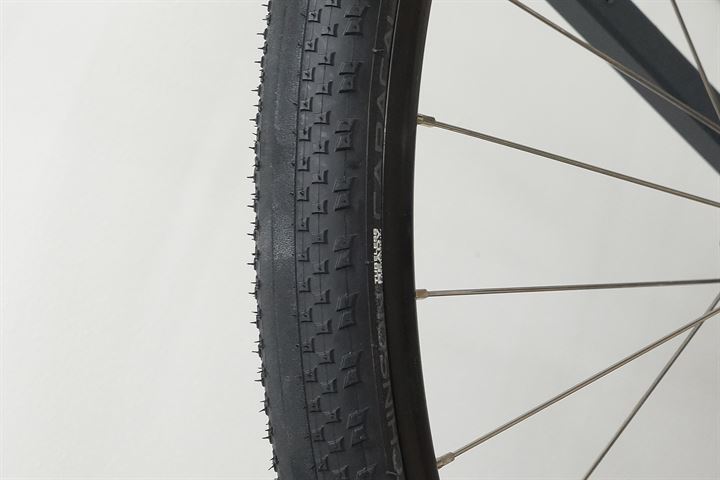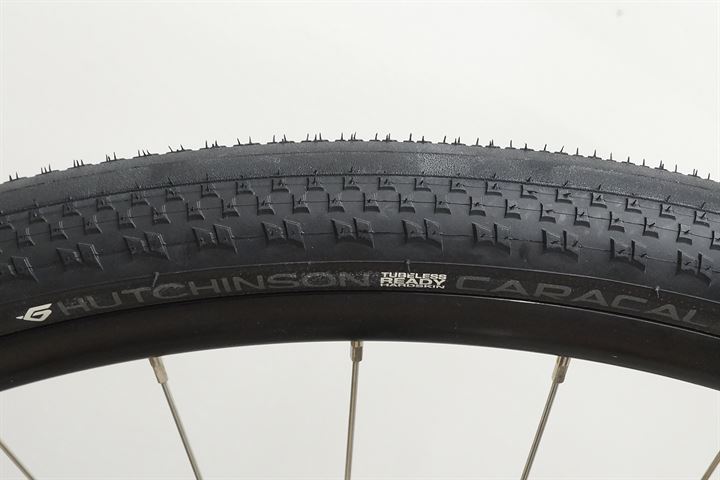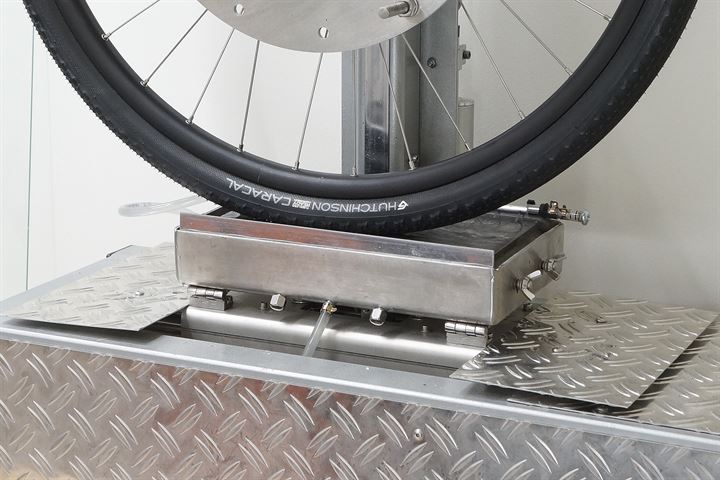CX/Gravel Tire Test: Hutchinson Caracal TLR 40
Contents and Test Summary
- Introduction
- Manufacturer Specifications
- Size, Weight, Thickness
- Rolling Resistance: 26.3 Watts
- Puncture Resistance: 41 Points
- Static Wet Grip: 71 Points
- Conclusion: 2.7 / 5 Not Recommended
- Comments
- Hutchinson Caracal TLR 40
(100% is best)

Hutchinson has introduced both the Caracal Race (read our review) and the regular Caracal this year; at first glance, there is very little difference between these tires. When we look at the two tires side by side, they appear identical except for the labeling, and we can imagine that this might be confusing for many people. Our tests indicate massive differences between the Caracal in Race version and the regular Caracal.
Ad Buy Hutchinson Caracal TLR at Amazon.com
Even when we examine the specifications of both tires, we don't see significant differences at first glance. Both tires have a 127 TPI tubeless-ready casing and weigh 475 grams in the 40-622 version. However, upon closer inspection of the casings, we see that the Race version has a "Swift Easy" casing, while the regular Caracal features the more common "Hardskin" casing by Hutchinson.
What also becomes clear from the specifications is that the Caracal Race comes with Hutchinson's state-of-the-art "Mach Tread 3.0" compound, while the Caracal has to rely on Hutchinson's well-known "Bi-Compound." Our tests show massive differences between the two tires, with the Caracal Race being superior in almost every aspect.
This test also clearly demonstrates that the old belief that a faster compound has less grip is not always true. We see with the Caracal (Race) that a more advanced compound has lower rolling resistance and offers more grip on our wet test surface.
Manufacturer Specifications
| Manufacturer Specs | |
|---|---|
| Brand | Hutchinson |
| Model | Caracal TLR |
| Year | 2024 |
| Supplied By | Bought in store |
| New or Used | New |
| Mileage | 0 km |
| Price Range | High |
| Buy At | Ad Amazon.com |
| Manufacturer part number | PV532781 |
| EAN | 3248382096236 |
| TPI | 127 |
| Compound | Bi-compound |
| Bead | Folding |
| ETRTO | 40-622 |
| Specified Weight | 475 grams |
| Max Air Pressure (psi) | 51 |
| Made In | Members Only |
| Available Sizes | 40-622 (700x40c) |
Hutchinson Caracal TLR 40 Test Results

Size, Weight, and Thickness Measurements
| Size, Weight, and Thickness Measurements | |
|---|---|
| Specified Weight | 475 grams |
| Measured Weight | 477 grams |
| Measured Width Casing | 39 mm (un-round) |
| Measured Width Tread | 40 mm |
| Measured Height | 36 mm (un-round) |
| Measured Knob Height Center | 0.0 mm |
| Measured Knob Height Edge | 1.2 mm |
| Measured Total Thickness Center (excluding knobs) | 2.80 mm |
| Measured Total Thickness Sidewall | Members Only |
| All size measurements are taken at low air pressure on a 17.8 mm inner width rim. | |
Rolling Resistance Test Results
| Rolling Resistance Test Results | |
|---|---|
| Inner Tube | None (30 ml sealant) |
| Measured Width | 39 mm |
| Rolling Resistance Real tire width in mm: 30-32 = 66 psi/4.6 bar 33-35 = 60 psi/4.1 bar 36-38 = 54 psi/3.7 bar 39-42 = 50 psi/3.4 bar 43-46 = 46 psi/3.2 bar 47-50 = 42 psi/2.9 barHigh Air Pressure (50 psi / 3.4 bar) |
Members Only |
| Rolling Resistance Real tire width in mm: 30-32 = 55 psi/3.8 bar 33-35 = 50 psi/3.4 bar 36-38 = 45 psi/3.1 bar 39-42 = 42 psi/2.9 bar 43-46 = 38 psi/2.6 bar 47-50 = 35 psi/2.4 barMedium Air Pressure (42 psi / 2.9 bar) |
Members Only |
| Rolling Resistance Real tire width in mm: 30-32 = 44 psi/3.0 bar 33-35 = 40 psi/2.8 bar 36-38 = 36 psi/2.6 bar 39-42 = 33 psi/2.3 bar 43-46 = 31 psi/2.1 bar 47-50 = 28 psi/1.9 barLow Air Pressure (33 psi / 2.3 bar) |
26.3 Watts CRR: 0.00788 |
| Rolling Resistance Real tire width in mm: 30-32 = 33 psi/2.3 bar 33-35 = 30 psi/2.1 bar 36-38 = 27 psi/1.9 bar 39-42 = 25 psi/1.7 bar 43-46 = 23 psi/1.6 bar 47-50 = 21 psi/1.4 barExtra Low Air Pressure (25 psi / 1.7 bar) |
33.3 Watts CRR: 0.00998 |
| The CX/Gravel section is a multi tire size section, air pressures have been adjusted to the measured casing width. All numbers are for a single tire at a speed of 29 km/h / 18 mph and a load of 42.5 kg / 94 lbs. Use the formula: RR (Watts) = CRR * speed (m/s) * load (N) to calculate rolling resistance at a given speed and load. |
|
Puncture Resistance Test Results

| Puncture Resistance Test Results (higher is better) | |
|---|---|
| Total Puncture Score Tread | 41 Points |
| Total Puncture Score Sidewall | Members Only |
| Tread Puncture Force Sharp Needle | Members Only |
| Tread Puncture Force Blunt Needle | Members Only |
| Tread Total Tire Thickness | 2.80 mm |
| Sidewall Puncture Force Sharp Needle | Members Only |
| Sidewall Puncture Force Blunt Needle | Members Only |
| Sidewall Total Tire Thickness | Members Only |
Hard Surface Static Grip Test Results

| Static Grip Test Results | |
|---|---|
| Wet Grip Average | 71 Points |
| Wet Grip Center | Members Only |
| Wet Grip Edge | Members Only |
| Measured Knob Height Center | 0.0 mm |
| Measured Knob Height Edge | 1.2 mm |
| Grip in points = coefficient of friction * 100 CX/Gravel grip test rim width = 23.0 mm |
|
| Wet Grip Test and Off-Road Tires (info) | |
Conclusion
- Hutchinson Caracal TLR 40
(100% is fastest - lightest - highest - strongest)
After our excitement over the Caracal Race (read our review), which we declared in our review as the fastest gravel bike tire on the market, the regular Caracal is a significant disappointment. The Caracal is inferior in nearly every aspect, with just a single bright spot regarding both the puncture resistance of the tread and the sidewalls, where the Caracal performs slightly better.
We find the difference in the rolling resistance tests particularly shocking, as we see at the lowest tire pressure that the rolling resistance of the regular Caracal is double that of the Caracal Race. The Caracal performs adequately in the wet grip tests, but the Caracal Race again proves to be significantly better with a superior score.
If you care about performance, go for the Caracal Race and forget the regular Caracal.
Compare the Hutchinson Caracal and Caracal Race on our comparison section.
Ad Buy Hutchinson Caracal TLR at Amazon.com
RATING:
2.7
/ 5
TEST VERDICT:
Not Recommended
